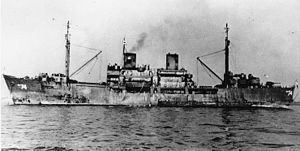Name USS Colusa (APA-74) Sponsored by Mrs J. F. Chandler Commissioned 20 December 1944 Launched 7 October 1944 Displacement 3.853 million kg | Namesake A county in California Acquired 18 December 1944 Decommissioned 16 May 1946 Length 130 m | |
 | ||
Builder Consolidated Steel Corporation | ||
USS Colusa (APA-74) was a Gilliam-class attack transport that served with the US Navy during World War II. Commissioned late in the war, she was initially assigned to transport duties and consequently did not participate in combat operations.
Contents
Colusa was named after a county in California. She was launched 7 October 1944 by Consolidated Steel at San Pedro, California, under a Maritime Commission contract; acquired by the Navy 18 December 1944; commissioned 20 December 1944, Lieutenant Commander H. W. Neill, USNR, in command; and reported to the Pacific Fleet.
Operational history
Colusa stood out from San Francisco 15 February 1945 for Pearl Harbor, arriving 21 February. She departed Pearl Harbor 27 February, discharged cargo at Eniwetok, Tinian, and Guam and returned to Pearl Harbor 26 March for training and inter-island transport duties until 24 June.
After a cargo-passenger voyage to Midway, she sailed 4 July from Pearl Harbor for San Francisco, where she disembarked passengers and loaded cargo for Pearl Harbor, returning 30 July.
After hostilities
After another voyage to carry men to Midway, Colusa departed Pearl Harbor 1 September and called at Saipan, Sasebo, Okinawa, and Wakayama on duty redeploying occupation personnel. Between 7 October, when she cleared Wakayama, and 5 January 1946, when she arrived at San Francisco, she crossed the Pacific on two Operation Magic Carpet voyages, calling at Guam, Seattle, Pearl Harbor, Nouméa, Brisbane, Hollandia, and Manus to load homeward-bound servicemen.
She sailed from San Francisco 16 January to transport Canadian naval officers to Sydney, Australia, called at Brisbane and New Caledonia, and returned to San Francisco 1 March.
Decommission
Colusa returned to Pearl Harbor 6 April, and there was decommissioned 16 May 1946, and transferred to the Maritime Commission 14 August 1947 for disposal. Her final disposition was the bikini islands where they had atomic bomb testings after the war
